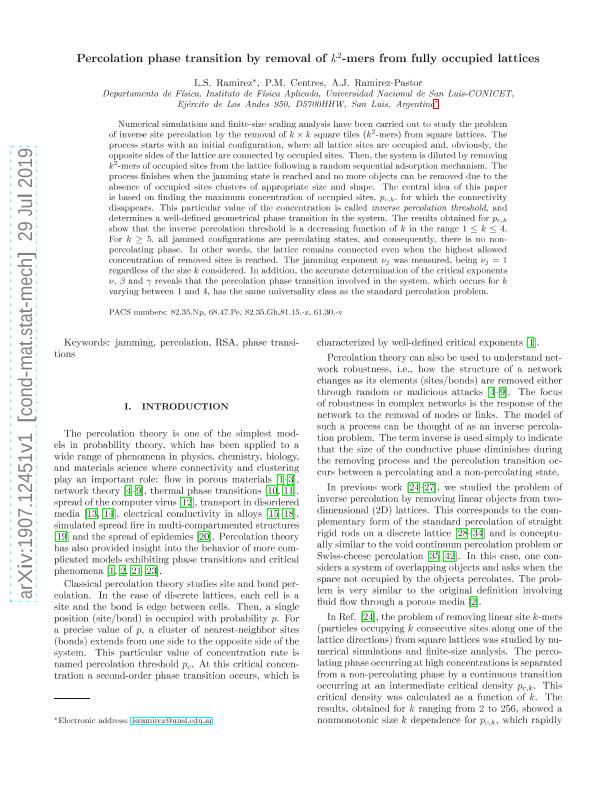Artículo
Percolation phase transition by removal of k2 -mers from fully occupied lattices
Fecha de publicación:
09/2019
Editorial:
American Physical Society
Revista:
Physical Review E
ISSN:
2470-0045
Idioma:
Inglés
Tipo de recurso:
Artículo publicado
Clasificación temática:
Resumen
Numerical simulations and finite-size scaling analysis have been carried out to study the problem of inverse site percolation by the removal of k×k square tiles (k2-mers) from square lattices. The process starts with an initial configuration, where all lattice sites are occupied and, obviously, the opposite sides of the lattice are connected by occupied sites. Then the system is diluted by removing k2-mers of occupied sites from the lattice following a random sequential adsorption mechanism. The process finishes when the jamming state is reached and no more objects can be removed due to the absence of occupied sites clusters of appropriate size and shape. The central idea of this paper is based on finding the maximum concentration of occupied sites, pc,k, for which the connectivity disappears. This particular value of the concentration is called the inverse percolation threshold and determines a well-defined geometrical phase transition in the system. The results obtained for pc,k show that the inverse percolation threshold is a decreasing function of k in the range 1≤k≤4. For k≥5, all jammed configurations are percolating states, and consequently, there is no nonpercolating phase. In other words, the lattice remains connected even when the highest allowed concentration of removed sites is reached. The jamming exponent νj was measured, being νj=1 regardless of the size k considered. In addition, the accurate determination of the critical exponents ν, β, and γ reveals that the percolation phase transition involved in the system, which occurs for k varying between one and four, has the same universality class as the standard percolation problem.
Palabras clave:
Jamming
,
Percolation
,
Phase transition
,
Monte Carlo
Archivos asociados
Licencia
Identificadores
Colecciones
Articulos(INFAP)
Articulos de INST. DE FISICA APLICADA "DR. JORGE ANDRES ZGRABLICH"
Articulos de INST. DE FISICA APLICADA "DR. JORGE ANDRES ZGRABLICH"
Citación
Ramírez, Lucía Soledad; Centres, Paulo Marcelo; Ramirez Pastor, Antonio Jose; Percolation phase transition by removal of k2 -mers from fully occupied lattices; American Physical Society; Physical Review E; 100; 3; 9-2019; 1-12; 032105
Compartir
Altmétricas




